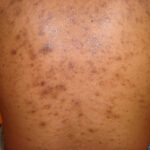Melasma, also known as chloasma, sometimes referred to as a Pregnancy’s mask is a skin condition that affects 50 to 70% of women, especially during pregnancy. Any shift in hormones can trigger melasma. Brown patches on the skin characterize it. Melasma can develop anywhere, but it often appears on the forehead, around the mouth (mainly upper the lip), around the cheeks, and the face’s outer perimeter.
What is the leading cause of melasma?
Although the exact cause of melasma is unknown, it occurs when (melanocytes) the cells that control pigment in your skin trigger an increase in melanin. As the melanin increases, certain areas of your skin become darker than others, but melasma patches tend to be more significant. However, people with darker skin tone are more prone to melasma because they have more active melanocytes than people with fair skin tone.
So, who is prone to melasma?
While anyone can technically get melasma, some are more susceptible to it than others.
Those with darker skin tone. As said earlier, melasma is an overproduction of melanin. People with darker skin tone naturally have a more active pigment production cell than those with lighter skin complexion. So it is easier for them to be overstimulated.
Pregnant women. 90% of individuals who get melasma are women, especially pregnant women. When melasma appears in pregnant women, it’s often referred to as chloasma or mask of pregnancy. Your estrogen level changes during pregnancy; these changing hormones lead to excessive melanin production and, in turn, the dark patches on your skin.
Sun exposure. The sun is the primary cause of melasma; UV rays from the sun stimulate the melanocytes. Just a small amount of sun exposure triggers melasma.
Skincare products. If a product/ ingredient irritates your skin, melasma can worsen
Those on hormonal medication. Melasma may occur when you either start or stop contraception, like birth control pills and hormone replacement can trigger melasma.
What are the best ways to treat melasma?
The first step in treating melasma is confirming with your dermatologist or skincare specialist that your skin color change is melasma and rule out what is causing it. Several treatments are available for melasma but not effective in every person. The treatment aims to fade the dark spots and make them go away. However, people with a dark complexion and those in a sunny climate may have persistent melasma for years or decades. The good news is that pregnancy-associated melasma improves once you stop taking birth control pills, after menopause, and within a few months after delivery.
So, how do we treat melasma after pregnancy?
Use Sunscreen
The purpose of melanin is to protect the skin from harmful UV radiation. When you expose yourself to the sun, your skin produces more melanin. You have to work hard to protect your skin from sun damage.
Wearing sunscreen will limit this process. Sunscreen protects the skin from UV rays, which reduces your melanin production. Choose a sunscreen with SPF 30 and above, broad-spectrum and water-resistant. Sunscreen does not prevent 100% of the UV rays. To further reduce how much melanin your skin produces, you should also remember to stay indoors when the sun rays are more robust, limit sun exposure, wear protective clothing, like sunglasses, hats, and long-sleeved
Antioxidants for melasma. You can also reduce melasma’s appearance with antioxidants like Vitamin C and E, safe and effective, helping heal the sun’s damage. Serums with these vitamins decrease melanin production, improve skin health and prevent the harmful effects of sun exposure.
Use Retinol
Retinoids are a must for melasma. They stimulate cell production by pushing dead and hyperpigmented skin cells to the surface and slough them off to give room for new and undamaged skin cells. Retinol can be irritating and can end up making melasma worst in some skin types. Apply once a week, and work your way up to every night, depending on how your skin is tolerant. Use the drug continually to maintain its benefits.
In addition to Retinoids, craft a specific skincare regimen with as many pigment production reducers and pigment lighteners, top with a sunscreen that protects against both UVA and UVB get the best results.
Stay out of the Sun. Sun damage is real; the sun is more vital than any treatment, especially among people with a dark complexion. UVB and UVB rays from direct sunlight lead to melasma. Protect your skin by wearing a broad-spectrum sunscreen that blocks sun’s rays, light, and heat, whether you are going out or staying indoors.
While most melasma cases will fade after pregnancy, there are many things to consider before committing to any peel or laser to treat melasma. Talk to your dermatologist first before changing your skincare routine. Most of all, protect your skin from the sun’s harmful rays



